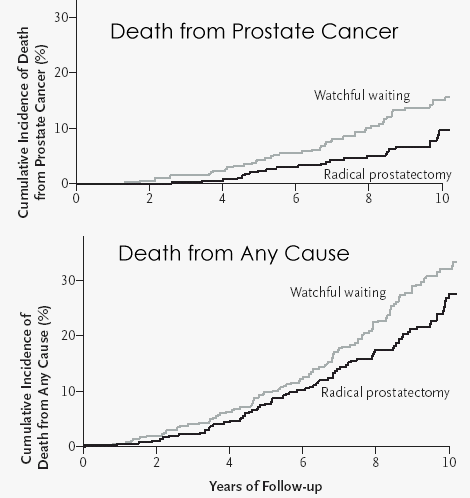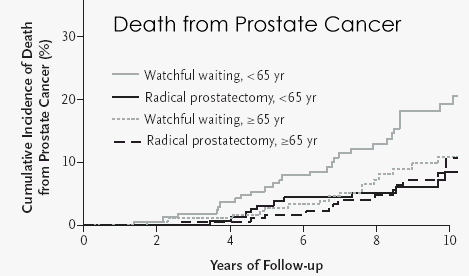Results During a
median of 8.2 years of follow-up, 83 men in the surgery group and 106 men in the
watchful-waiting group died (P=0.04). In 30 of the 347 men assigned to surgery (8.6
percent) and 50 of the 348 men assigned to watchful waiting (14.4 percent), death was due
to prostate cancer. The difference in the cumulative incidence of death due to prostate
cancer increased from 2.0 percentage points after 5 years to 5.3 percentage points after
10 years, for a relative risk of 0.56 (95 percent confidence interval, 0.36 to 0.88;
P=0.01 by Gray's test). For distant metastasis, the corresponding increase was from 1.7 to
10.2 percentage points, for a relative risk in the surgery group of 0.60 (95 percent
confidence interval, 0.42 to 0.86; P=0.004 by Gray's test), and for local progression, the
increase was from 19.1 to 25.1 percentage points, for a relative risk of 0.33 (95 percent
confidence interval, 0.25 to 0.44; P<0.001 by Gray's test).

Conclusions Radical prostatectomy reduces disease-specific mortality, overall
mortality, and the risks of metastasis and local progression. The absolute reduction
in the risk of death after 10 years is small, but the reductions in the risks of
metastasis and local tumor progression are substantial. Our 10-year estimates show that
radical prostatectomy is associated with a statistically significant reduction in all the
end points that we investigated, with a relative reduction of 44
percent in mortality due to prostate cancer, of 26 percent in overall mortality, of 40
percent in the risk of distant metastasis, and of 67 percent in local progression.
Since, in absolute terms, the reduction in mortality is moderate, clinical decision making
and patient counseling will remain difficult. The additional finding that radical
prostatectomy substantially reduces the risk of metastasis and symptomatic local tumor
growth may, however, be of some help in guiding therapy, and we expect that the benefits
of this surgery will increase during longer periods of follow-up. |


